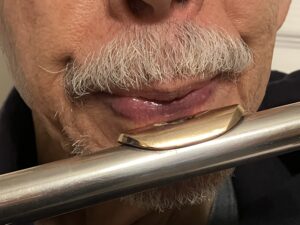I know what you probably are thinking. You only have one mouth. How can there be different embouchures with the same mouth?
Believe it or not you change the shape of your lips and mouth depending whether you are playing in the low, medium, or high range on your flute. Most of the other woodwind instruments have an octave key when they need to play low or high. On the flute our octave key is our mouth.
What we do is to slowly change the embouchure as we either go higher or lower when playing the flute. Our embouchure is in constant motion depending where we are pitch wise.
Most beginner/intermediate players use only one or at best two different embouchures when they play. Because of that fact they have a lot of trouble trying to play above the staff and are extremely sharp and non-focused.
Chart demonstrating how out-of-tune a flute is naturally with no embouchure adjustment
| Pitch | Very Flat | Flat | OK | Sharp | Very Sharp |
| C1 (below staff) | * | ||||
| D1 | * | ||||
| E1 | * | ||||
| F1 | * | ||||
| G1 | * | ||||
| A1 | * | ||||
| B1 | * | ||||
| C2 (in the staff) | * | ||||
| D2 | * | ||||
| E2 | * | ||||
| F2 | * | ||||
| G2 | * | ||||
| A2 | * | ||||
| B2 | * | ||||
| C3 (above the Staff) | * | ||||
| D3 | * | ||||
| E3 | * | ||||
| F3 | ** | ||||
| G3 | *** | ||||
| A3 | *** | ||||
| B3 | * | ||||
| C4 | *** |
As you can see from the chart the flute is no more in tune than any other instrument. We have to play them in tune either through alternate fingerings or embouchure adjustment. The flute is naturally very flat in the bottom range. In the middle range it is somewhat out of tune with some notes worse than others. When we finally get to the third octave the flute can be as much as 50-70% sharp on some notes. Changing our embouchure is how we make the adjustments to pitch.
The problem is that you have to change the direction of the air coming out of your mouth to be able to play the notes in the different ranges on your flute.
In the lowest range (C1-C2) your lips should be pulled back flat against your teeth (almost like someone pulled the corners of your mouth back gently but not too tight).
Picture of fingers pulling corners of mouth back

Your jaw should be slightly protruding and your teeth should be open a little pinky’s width. The air coming out of your mouth is aimed almost 90% out from your lips and face.
Picture 1-Lowest Embouchure

When we get to D2-F2) our lips have begun to relax and come forward (almost like you are asleep). By moving the corner of the lips more forward the direction of the airstream is now aiming a little more down into the flute.
Picture 2-Middle Range Embouchure

When we finally get above G2 now our embouchure is very relaxed and almost like we are saying the words “Winnie-The Pooh.” And believe it or not the higher we go the more our teeth should be open! Now the air stream is aiming down into the flute even more.
Picture 3-3rd Embouchure

A great way to practice this technique is to play larger intervals or even octaves. You can start with a Bb in the staff and then try slurring to the Bb above the staff (don’t cheat and tongue the high Bb). When you tongue you are not changing your embouchure. Slurring forces you to use your embouchure. When you are able to slur up to the octave then try going up and back down while you are slurring all three notes (in the same breath). When you get to the point you can slur up AND down then your choppers are starting to come around. And make sure when you slur up do not get louder! Make your embouchure do the work, not your air pressure.


This is an exercise I give my students when they are learning how to slur through their embouchure changes. Notice that you get softer when you go high and louder when you come back down to the starting note. When you get good at the exercise then you are ready to move on to more advanced studies. See below:

For more advanced students I would suggest a great etude book for interval study by the acclaimed French flute teacher Marcel Moyse. The book is called 20 Exercises & Studies. It is a wonderful book for studying intervals and working your embouchure.
I know that it looks brutal! Take it slow and try a little bit every day. After a few days you will get the hang of it and be a wiz with your embouchure. And the beauty of this is when you use your embouchure properly, everything is easier to play, much clearer AND in tune! Good luck!
